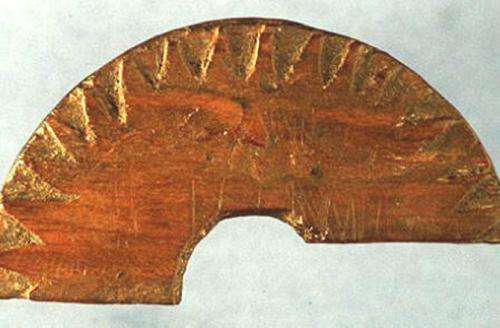March 26, 2014 weblog
Researchers suggest Vikings used crystals with sun compass to steer at night

(Phys.org) —A team of researchers working in Hungary has proposed that a sun compass artifact found in a convent in 1948 might have been used in conjunction with crystals to allow Vikings to guide their boats even at night. In their paper published in Proceedings of the Royal Society A: Mathematical, Physical & Engineering Sciences, the team describes theories they've developed that might explain how Viking sailors were able to so accurately sail to places such as Greenland.
Since the discovery of the sun compass fragment, researchers have theorized that Viking sailors used them to plot their course—at least when the sun was shining. They didn't have magnetic compasses, however, which suggest they must have had some other means for steering in the evening or the later hours. In this latest effort, the researchers describe a scenario where the Vikings might have used a type of crystal that they called a sunstone to help them use light from the sun below the horizon as a guide.
The sun compass fragment, prior research has suggested, operated in similar fashion to a sundial, using the position of the sun to determine direction, instead of time. Some have suggested the Vikings also used a dome shaped object with slits in it, placed on top of the compass to help narrow the light during the time when the sun moved low towards the horizon. The researchers in Hungary are now suggesting that they also added calcite stone crystals for use after the sun went below the horizon. They've conducted tests which show that the crystals can be used to note where the sun is after it's passed below the horizon, because they direct ultraviolet light into patterns inside the stone, which can be seen by the human eye. If such stones were used, the Vikings could have used them all night long in the northern latitudes as it never goes completely dark.
The researchers back up their theory by noting that Viking literature is rife with references to sun stones, though none have ever been "officially" discovered. One crystal has been found amongst navigational tools on a sixteenth century sunken ship, but no one has been able to prove it was actually used as a navigational aid.
More information: How could the Viking Sun compass be used with sunstones before and after sunset? Twilight board as a new interpretation of the Uunartoq artefact fragment, Proceedings of the Royal Society A, Published 26 March 2014 DOI: 10.1098/rspa.2013.0787
Abstract
Vikings routinely crossed the North Atlantic without a magnetic compass and left their mark on lands as far away as Greenland, Newfoundland and Baffin Island. Based on an eleventh-century dial fragment artefact, found at Uunartoq in Greenland, it is widely accepted that they sailed along chosen latitudes using primitive Sun compasses. Such instruments were tested on sea and proved to be efficient hand-held navigation tools, but the dimensions and incisions of the Uunartoq find are far from optimal in this role. On the basis of the sagas mentioning sunstones, incompatible hypotheses were formed for Viking solar navigation procedures and primitive skylight polarimetry with dichroic or birefringent crystals. We describe here a previously unconceived method of navigation based on the Uunartoq artefact functioning as a 'twilight board', which is a combination of a horizon board and a Sun compass optimized for use when the Sun is close to the horizon. We deduced an appropriate solar navigation procedure using a twilight board, a shadow-stick and birefringent crystals, which bring together earlier suggested methods in harmony and provide a true skylight compass function. This could have allowed Vikings to navigate around the clock, to use the artefact dial as a Sun compass during long parts of the day and to use skylight polarization patterns in the twilight period. In field tests, we found that true north could be appointed with such a medieval skylight compass with an error of about ±4° when the artificially occluded Sun had elevation angles between +10° and −8° relative to the horizon. Our interpretation allows us to assign exact dates to the gnomonic lines on the artefact and outlines the schedule of the merchant ships that sustained the Viking colony in Greenland a millennium ago.
Journal information: Proceedings of the Royal Society A
© 2014 Phys.org





















